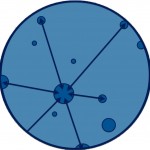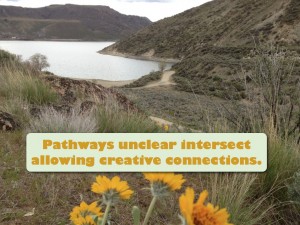From Susan Spellman-Cann we continue the gift of #ETMOOC and will enjoy an anniversary event complete with chats and Google Hangouts. Join the Post ETMOOC community and the #etmchat .
What is ETMOOC… Here is Susan Spellman-Cann‘s explanation in HaikuDeck
Created with Haiku Deck, the free presentation app for iPad
My HaikuDeck is One Slide about the effect of #ETMOOC
Created with Haiku Deck, the free presentation app for iPad
After ETMOOC, I reflected on the experience in a blog post – Unfinal Reflection, because it truly has been the gift that keeps on giving.
This is my post — revised and updated for today’s anniversary. Revisions are bold and blue.
How do you plan on staying connected to the people and the ideas?
This unfinal post for #etmooc reviews the path I now take with others to continue the journey: #etmooc continues to drop it’s pebble of ideas into the ocean of possibilities, creating ripples of overlapping connections forever spreading and growing.
My own questions and final thoughts:
- Given the access, technology, resources, and requirements available to me, how can I create a classroom world reflective of what my students need in the future that is theirs?
- How do I need to adapt my pedagogy to create that classroom?
- Of course I’m torn between what it seems students need and the reality of our school district’s focus on test success.
- As I can, technology provides us with reflection and collaboration tools. It helps one class teach another. For instance my sixth grade students created cyber-safety and Google Apps lessons for grade five students. They also, while learning figurative language themselves are creating a resource for other students in our school by collaborating on a Google presentation.
- In all our online work, we strive to leave positive footprints, practicing our digital footprints.
- In one class, we are learning with Mozilla on how to code. Our first project was Six Word Memoirs. Code is the language of the future, and we’re beginning to learn to translate! It was a riot: “Change size of text on line 20,” one student would call out, then hop up to guide another students. The puzzle of code unravelled.
- More and more I learn to share with students the overall goal of our requirements, and students choose the project and details that they require to learn: personalized learning
- This is not easy to accomplish: the requirements of school’s today are not reflective of the reality of interactions, composition, and collaboration practiced by successful workers and thinkers.
- Today, I work with a new crew of teacher bloggers who are blogging with their students; we are creating a community for our students to collaborate through blogs: #teach2blog twubs and Google Plus Community
- How will like-minded teachers connect and collaborate to create connected spaces for themselves and with their students?
- How will I, as a middle school teacher of language arts, connect with others to ponder these questions, create a space to act on them, and discover together ways to improve education in our own worlds.
- As a result of #etmooc, not only have a Connect in the Middle Wiki for middle level educators, but several of us have joined in several different communities:
- Post-Etmooc Blog Readers and #etmchat
- Reflective Vlogging and Open Spokes Fellowship
- Mozilla Webmakers –I’d sure like to have teacher accounts here; the updated version doesn’t give us access because we need to sign in. Last year we could use the tools [thimble] without signing in.
- Open Online Experience Planning [Brendan Murphy hosted an excellent experience here]
- Ben Wilkoff started the Open Spokes Fellowship as a result of conversation in #etmooc. He invited a group of teachers who will weekly vlog on topics about education, forming a neighborhood of differences in order to discuss common ground and forge a future that benefits the students we teach. We are raising our voices from separate whispers to a chorus we hope will be heard, shared, discussed, and acted upon by others who likewise wish to move forward in this education transformation. Thanks to Ben’s leadership and the amazing educators within this group, we continue to vlog! We also have a Google Plus Reflective Vlog Community. Check them out.
- The Connect in the Middle Wiki for middle level educators did not work out as planned; that’s how life works. Sometimes things take off and sometimes they don’t. For this wiki, the educators moved to their[ our ] passions: GeniusHour Wiki by Gallit, Joy, and Denise. Be sure to check it out.
- As a result of #etmooc, not only have a Connect in the Middle Wiki for middle level educators, but several of us have joined in several different communities:
I thank #etmooc for providing connections to inspiring people, whom I thank here:
I so enjoyed the recorded session with the participants of Jesse Strommel’s DigiWriting #etmooc, A Flurry of Cursors.
Some of us began an Adventure story. ( @mrsdkrebs)
During one session, Darren Kuropatwa asked participants to record and share 5 seconds of video with him viaDropitTOme and then compiled them into this “Beauty” short video. He invited others to Popcorn it ! Here is mine after an inspirational video remix by Rhonda Jessen.
A few of us gathered videos into which I popped this for the group: Where do you learn?
 I thank Alec Couros for the #etmooc that reconnected me with Ben Wilkoff who created a Professional Learning Neighborhood in the Open Spokes Fellowship. Please stop by now and then, #etmooc’ers!
I thank Alec Couros for the #etmooc that reconnected me with Ben Wilkoff who created a Professional Learning Neighborhood in the Open Spokes Fellowship. Please stop by now and then, #etmooc’ers!
#etmooc lives on because:
If you didn’t participate in #ETMOOC, please join #etmchat and Post ETMOOC Community to engage with encouraging and creative people!


